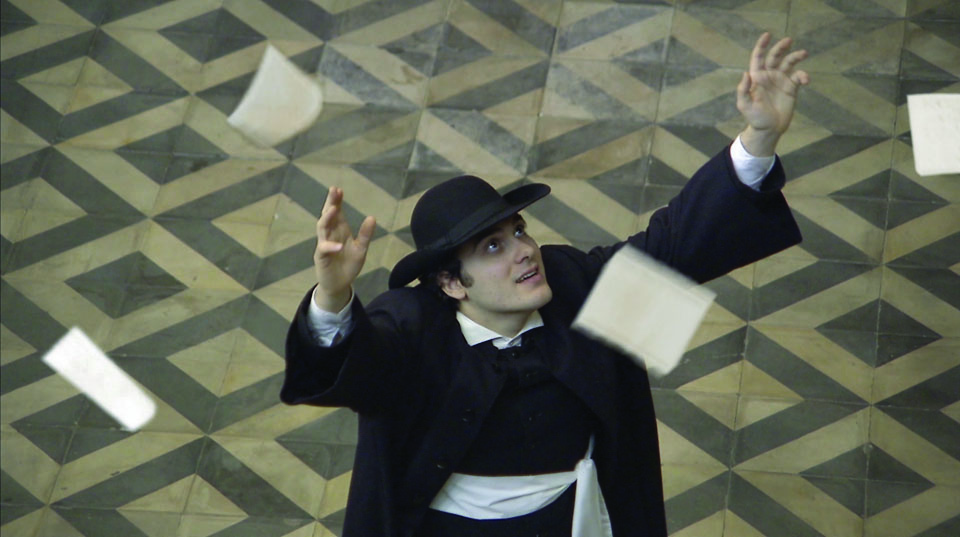On 20 Settembre 2015 /
Senza categoria /
Commenti disabilitati su LA VIA DELL’ANIMA – Giornate bolognesi 2015 / 6 e 7 ottobre

——————————————————————————————————-
BOLOGNA Strada Maggiore 34
MUSEO INTERNAZIONALE
E BIBLIOTECA DELLA MUSICA
· martedì 6 ottobre ore 16.00
Proiezione del film di Georg Brintrup
Santini’s Netzwerk (La rete di Santini)
Tavola rotonda
“Dove andavamo/dove n’andremo?”
moderata da Flavio Colusso con la partecipazione di
Marco Beghelli (Università di Bologna)
Georg Brintrup (regista)
Andrea Lausi (Dir. artistico Festival WunderKammer di Trieste)
Massimo Mercelli (Dir. artistico Emilia Romagna Festival)
Mario Messinis (Dir. artistico Bologna Festival)
Michele Vannelli (M° di Cappella Basilica di San Petronio)
Alessandro Zignani (scrittore e critico musicale),
· mercoledì 7 ottobre ore 15.00
Giornata di studi
presieduta da Rossana Dalmonte
Alfredo Vitolo (Museo della musica di Bologna)
Gaetano Gaspari e Fortunato Santini
Michele Vannelli (Cappella Musicale di San Petronio)
Le Sonate di Tinazzoli a Münster
Luigi Verdi (Conservatorio “S. Cecilia” di Roma)
I manoscritti musicali di Settimio Battaglia (1815-1891) tra
Europa, Israele e America latina. Nel 200° anniversario della
nascita del compositore romano
· mercoledì 7 ottobre ore 17.45
Concerto (ticket € 6)
Sonate, e capricci per il cembalo (1727) di Agostino Tinazzoli
(dal manoscritto della Collezione Santini di Münster)
MICHELE VANNELLI clavicembalo
LA VIA DELL’ANIMA è un progetto nato per valorizzare i tesori musicali che il musicista e collezionista romano Fortunato Santini cedette nel 1862 alla Diocesi di Münster, oggi conservati nella modernissima Diözesanbibliothek.
Santini, il quale abitava a Roma in via di Santa Maria dell’Anima – a pochi passi dalla omonima chiesa della comunità di lingua tedesca – fece del suo appartamento un luogo d’incontro per musicisti provenienti da tutta Europa, creando una “rete” di scambi culturali che ha contribuito alla formazione di importanti raccolte e archivi tra cui la sua eccezionale collezione che, con più di 20.000 titoli, è una delle più preziose fonti di musica dal XVI al XIX secolo.
L‘iniziativa mette in “connessione” le istituzioni musicali delle città europee dove operavano i corrispondenti epistolari della “rete di Santini” come, per citarne solo alcuni, Mendelssohn, Liszt, Stasov, Zelter, Gaspari. Fra i numerosi meriti che tali personaggi ebbero vi è quello, � finora sottovalutato, di stimolare non solo a collezionare musica del passato ma a farla eseguire in pubblico contribuendo così, con la loro passione, alla avventurosa rinascita della “musica antica”. A Berlino, Berna, Bologna, Bruxelles, Halle, Parigi, Oxford, San Pietroburgo, Vienna, etc., si uniscono oggi tutte quelle città e istituzioni che condividono la ricerca e l’esecuzione della musica antica, intesa come conoscenza del passato e come “radice” del fruttuoso futuro.
Ideato da Georg Brintrup e Flavio Colusso il progetto è coordinato da Musicaimmagine ed è stato avviato nel 2013 con il � film Santini’s
Netzwerk prodotto per la Televisione tedesca WDR con un cast internazionale e gli interpreti musicali dell’Ensemble Seicentonovecento, della Cappella Musicale di Santa Maria dell’Anima e della Capella Ludgeriana della città westfaliana.
Al progetto hanno � nora aderito la Diözesanbibliothek, l’Istituto di Musicologia della Westfälische Wilhems-Universität, l’Istituto Storico Germanico, il Pontificio Istituto di Musica Sacra, l’Accademia Nazionale di Santa Cecilia, il Conservatorio “S. Cecilia”, la Cappella Musicale di San Petronio, la Fondazione Istituto Liszt e il Museo della Musica di Bologna, l’Emilia Romagna Festival, il Festival “Le vie del Barocco” di Genova, il Festival “Flatus” di Sion, il Norddeutscher Figuralchor di Hannover, l’Università di Osnabrück.
Santini’s Netzwerk (La rete di Santini)
Film di Georg Brintrup [WDR, 85’ Italia-Germania, 2013]
trama: l’abate Fortunato Santini (1778-1862) nutriva profonda e autentica passione per la musica. Fin dall’età di vent’anni si impossessò di lui un’aspirazione irresistibile che poi divenne lo scopo della sua vita: collezionare autogra� o copie di musica antica e farla ancora eseguire!
In soli cinquanta anni attraverso una rete internazionale di scambi la collezione divenne una delle biblioteche musicali più complete al mondo con partiture di Scarlatti, Händel, Bach, Pergolesi, Palestrina, Carissimi e molti altri; opere che sarebbero andate perdute ci sono pervenute grazie alla collezione di Santini.
Ma cosa muoveva quest’uomo a realizzare una tale impresa? Era istinto, passione? O lo faceva, invece, per lucrare? E come mai la collezione si trova oggi a Münster, in Westfalia, e non a Roma?
produzione Lichtspiel Entertainment, WDR, MEDIA Programme of the European
Union, Film und Medienstiftung NRW produttore esecutivo Wulf-Ernst Hoffer scritto e diretto da Georg Brintrup sceneggiatura Georg Brintrup, Mario Di Desidero, Jobst Grapow musiche Flavio Colusso scene e costumi Raffaele Golino fotogra� a Benny Hasenclever, Marco Leopardi, Diego D’Innocenzo, Dieter Fietzke, Alessandro Iafulla, Valerio Cesaroni effetti speciali Michael Spengler suono Francesco Sardella, Tobias Welmering, Eckhard Glauche, Rene Göckel
cast Renato Scarpa (Fortunato Santini), John Gayford (Edward Dent), Maximilian Scheidt (Felix Mendelssohn Bartholdy), Claudio Marchione (Giuseppe Jannacconi), Domenico Galasso (Giuseppe Baini), Pietro M. Beccatini (Cardinale Odescalchi), Harald Redmer (Carl-Friedrich Zelter), Cristian Giammarini (Bernhard Quante), Antonio Giovannini (Mariano Astol� , contralto), Florian Steffens (Dent giovane), Emanuele Paragallo (Santini giovane), Marco Verri (Baini giovane), Michele Tomaiuoli (Franz Liszt)
produzione musicale Musicaimmagine direttore di produzione Silvia De Palma
interpreti musicali Margherita Chiminelli, Maria Chiara Chizzoni, Arianna Miceli, Alessandro Carmignani, Jean Nirouët, Maurizio Dalena, Paolo Fanciullacci, Matteo Bellotto, Walter Testolin, Andrea Coen, Andrea Damiani, Stefano Fiuzzi, Ensemble Seicentonovecento, Cappella Musicale di S. Maria dell’Anima, Capella Ludgeriana e Mädchenchor del Duomo di Münster (dir. Andreas Bollendorf e Verena Schürmann) direttore Flavio Colusso
